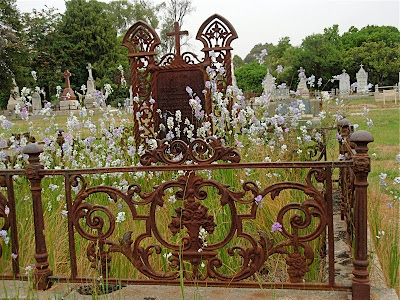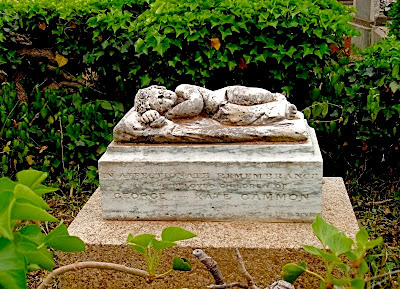November 20Another day of dark, dust-laden skies and intense heat.
Before we left Rutherglen, I wanted to visit the grand All Saints Winery, which I remembered from a long-ago trip in my youth. We slightly lost our way, driving across the Murray into New South Wales, getting directions, and driving back over a different bridge into Victoria again.
The winery had an avenue of elms that must make European visitors sigh for the good old days before Dutch elm disease wiped out most of theirs.

The last time I visited, most Australians were still drinking sweet sherry and a sparkling wine called Porphyry Pearl. You can imagine! How different it is today. The imposing building is now immaculately landscaped,

and there are reception rooms lined with oak casks for weddings and other functions, a deli selling cheese, jams and olive oils, and of course a large and attractive tasting room. They are experimenting with European varietals so we bought a bottle of their latest combo: Tempranillo Grenache, a light fruity red.
After that we made for Beechworth, a town we'd been to before and remembered as an appealing stopover.

It still is attractive, and very much more upscale, with many shops selling fancy soaps, French linens, crafts and home decor items.
Almost unchanged, however, is its wonderful old cemetery with faded headstones and rusting ironwork. Wildflowers (a lavender form of
Ixia, I think) were growing on many of the grave sites.


There was a sad little memorial to eight children of the Gammon family, all of whom died between the ages of 2 and 9. Another two children survived.

And, Beechworth being once the source of a gold strike, there was a marvellous and moving Chinese section with traditional burning towers and at least a hundred simple headstones arranged randomly around them.


Around 4:30 just after we returned to the caravan park, the weather broke with gusting wind whipping dust, leaves and seed pods through everyone's little homes on wheels. Several owners struggled to haul down their flapping awnings, and we all retreated inside. Our barometer swung wildly over, the air cooled, kookaburras laughed as they so often do when rain is coming, sporadic raindrops splattered mud on windows, and a couple of little girls ran out and jumped in the rapidly forming puddles. For the first time since we began this trip we hunkered down inside the van for the rest of the evening.